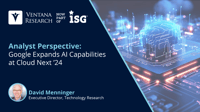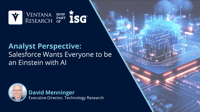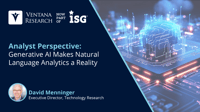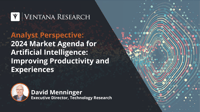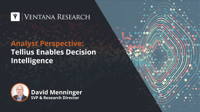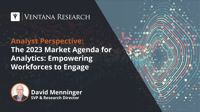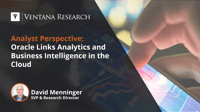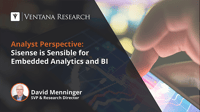The artificial intelligence (AI) market is exploding with activity, which is part of the reason we recently announced that we have dedicated an entire practice at Ventana Research to the topic. Large language models (LLMs) and generative AI (GenAI) have taken the AI world by storm. In fact, we assert that through 2026, one-half of all AI investments will be based on generative rather than predictive AI. My colleague Rob Kugel has written about how AI can improve productivity and benefit the...
Read More
Topics:
AI,
natural language processing,
AI & Machine Learning,
Analytics & Data,
Generative AI
I recently attended the Salesforce Trailblazer DX event to learn more about Salesforce’s artificial intelligence products and strategy. Fueled by generative AI, awareness and investment in AI seems to be exploding. ISG research shows that enterprises plan to nearly triple the portion of budgets allocated to AI over the next two years. This doesn’t come as a big surprise when you look at the outcomes enterprises are achieving: Of those that have invested in AI, more than 8 in 10 (84%) have had...
Read More
Topics:
Artificial intelligence,
AI,
natural language processing,
Generative AI,
Deep Learning,
Model Building and Large Language Models,
Computer Vision,
Machine Learning Operations
We’ve been saying for years that natural language processing (NLP) and natural language analytics would greatly expand access to analytics. However, prior to the explosion of generative AI (GenAI), software providers had struggled to bring robust natural language capabilities to market. It required considerable manual effort. Many analytics providers had introduced natural language capabilities, but they didn’t really resonate with enterprise requirements. They required significant effort to...
Read More
Topics:
Business Intelligence,
Artificial intelligence,
natural language processing,
AI & Machine Learning,
Analytics & Data,
GenAI
Ventana Research recently announced its 2024 Market Agenda for Artificial Intelligence, continuing the guidance we have offered for two decades to help enterprises derive optimal value from technology and improve business outcomes.
Read More
Topics:
Artificial intelligence,
natural language processing,
Generative AI,
Deep Learning,
Model Building and Large Language Models,
Computer Vision
MicroStrategy is a long-standing business intelligence and analytics vendor that operates worldwide. Founded in 1989, this publicly traded company with hundreds of millions of dollars in revenue recently held its first in-person conference since prior to the pandemic. Similar to previous in-person events, the event was well attended by about 2,000 attendees and exhibitors. The theme, “MicroStrategy ONE,” is a way to explain the breadth of capabilities the company offers. The breadth of the...
Read More
Topics:
embedded analytics,
Analytics,
Business Intelligence,
Digital Technology,
natural language processing,
Analytics & Data
Artificial intelligence (AI) has evolved from a highly specialized niche technology to a worldwide phenomenon. Nearly 9 in 10 organizations use or plan to adopt AI technology. Several factors have contributed to this evolution. First, the amount of data they can collect and store has increased dramatically while the cost of analyzing these large amounts of data has decreased dramatically. Data-driven organizations need to process data in real time which requires AI. In addition, analytics...
Read More
Topics:
Analytics,
Digital Technology,
natural language processing,
AI & Machine Learning,
Analytics & Data
Organizations are continuously searching for new business opportunities hidden in their data. They are using various technologies including artificial intelligence and machine learning (AI/ML) to uncover granular insights that can support decision-making. Existing tools and dashboards are effective for observing standard metrics; however, they do not address follow-up questions, such as why things are happening or how those events impact performance. Organizations also struggle to derive...
Read More
Topics:
Analytics,
Business Intelligence,
natural language processing,
AI & Machine Learning,
Decision Intelligence
Ventana Research recently announced its 2023 Market Agenda for Analytics, continuing the guidance we have offered for nearly two decades to help organizations derive optimal value from technology investments to improve business outcomes.
Read More
Topics:
embedded analytics,
Analytics,
Business Intelligence,
Data,
Digital Technology,
natural language processing,
Process Mining,
Analytics & Data,
Collaborative & Conversational Computing
Organizations conduct data analysis in many ways. The process can include multiple spreadsheets, applications, desktop tools, disparate data systems, data warehouses and analytics solutions. This creates difficulties for management to provide and maintain updated information across multiple departments. Our Analytics and Data Benchmark Research shows that organizations face a variety of challenges with analytics and business intelligence. One-third of participants find it difficult to integrate...
Read More
Topics:
embedded analytics,
Analytics,
Business Intelligence,
natural language processing,
AI & Machine Learning
Embedded business intelligence (BI) continues to transform the business landscape, enabling organizations to quickly interpret data and convert it into actionable insights. It allows organizations to extract information in real time and answer wide-ranging business questions. Embedding analytics helps tackle the issue of extracting information from data which is a time-consuming process. Our research shows organizations spend more time cleaning and optimizing data for analysis rather than...
Read More
Topics:
embedded analytics,
Analytics,
Business Intelligence,
natural language processing,
Streaming Analytics,
AI & Machine Learning
